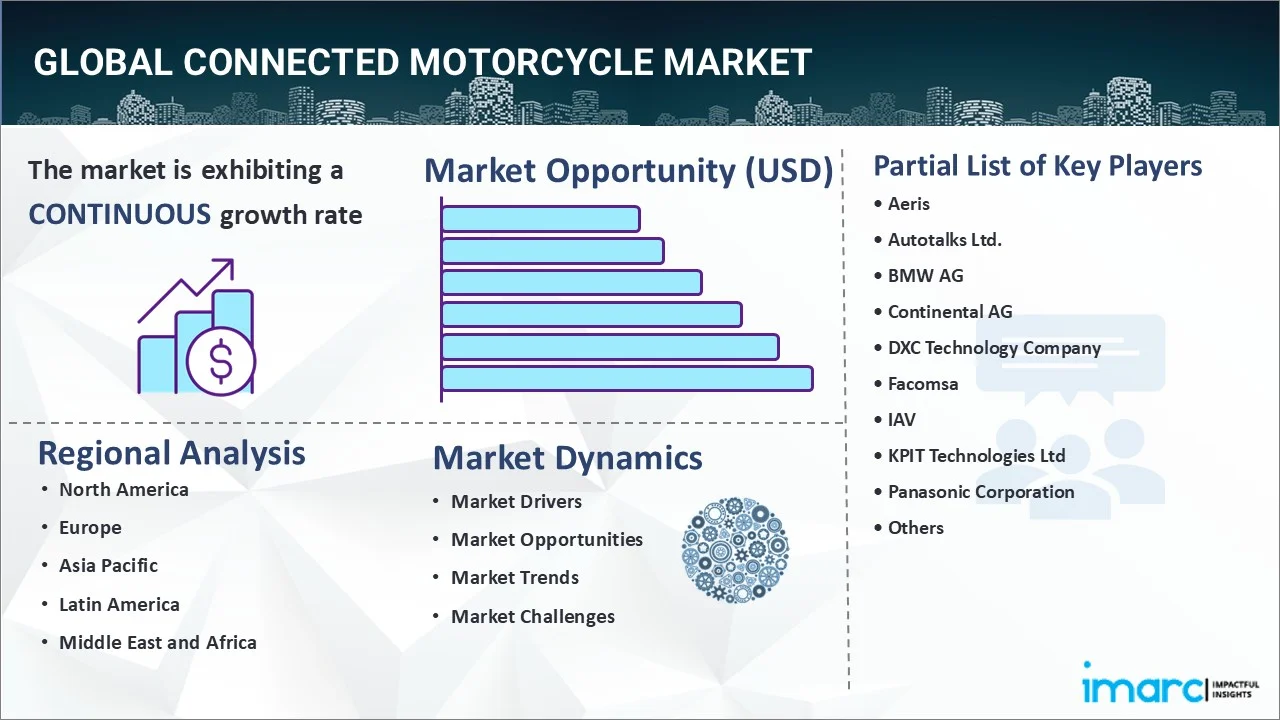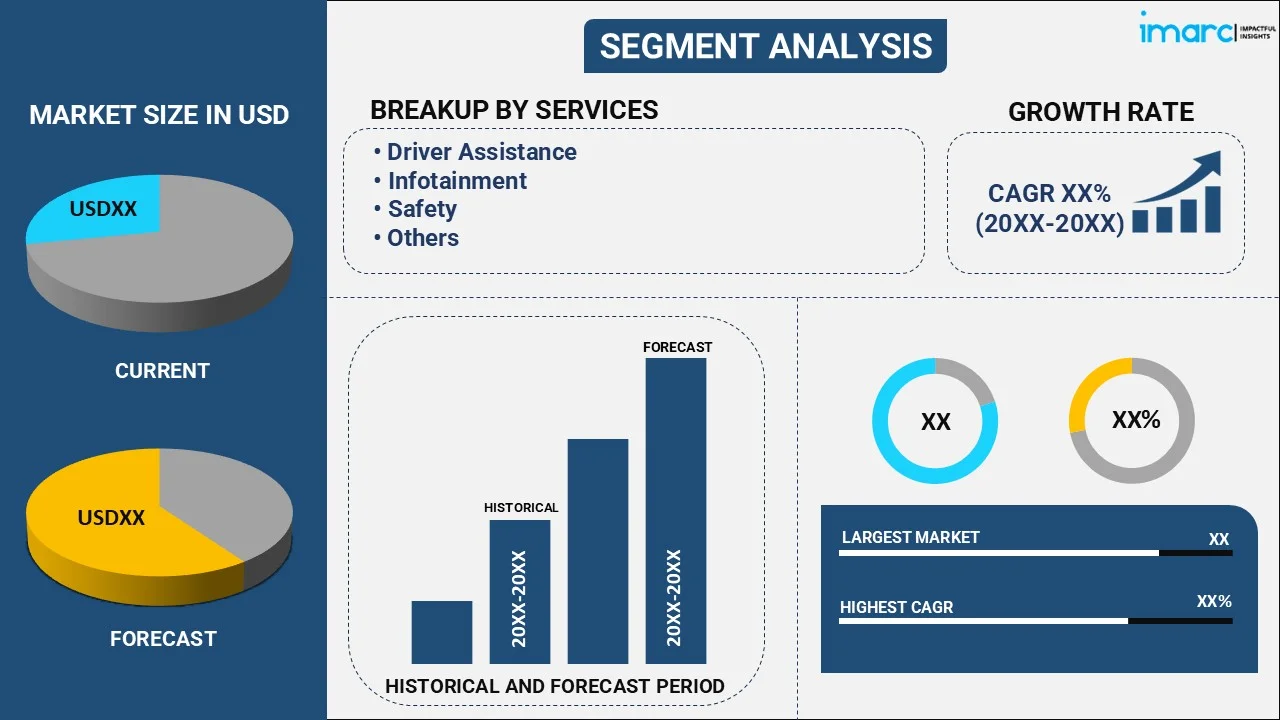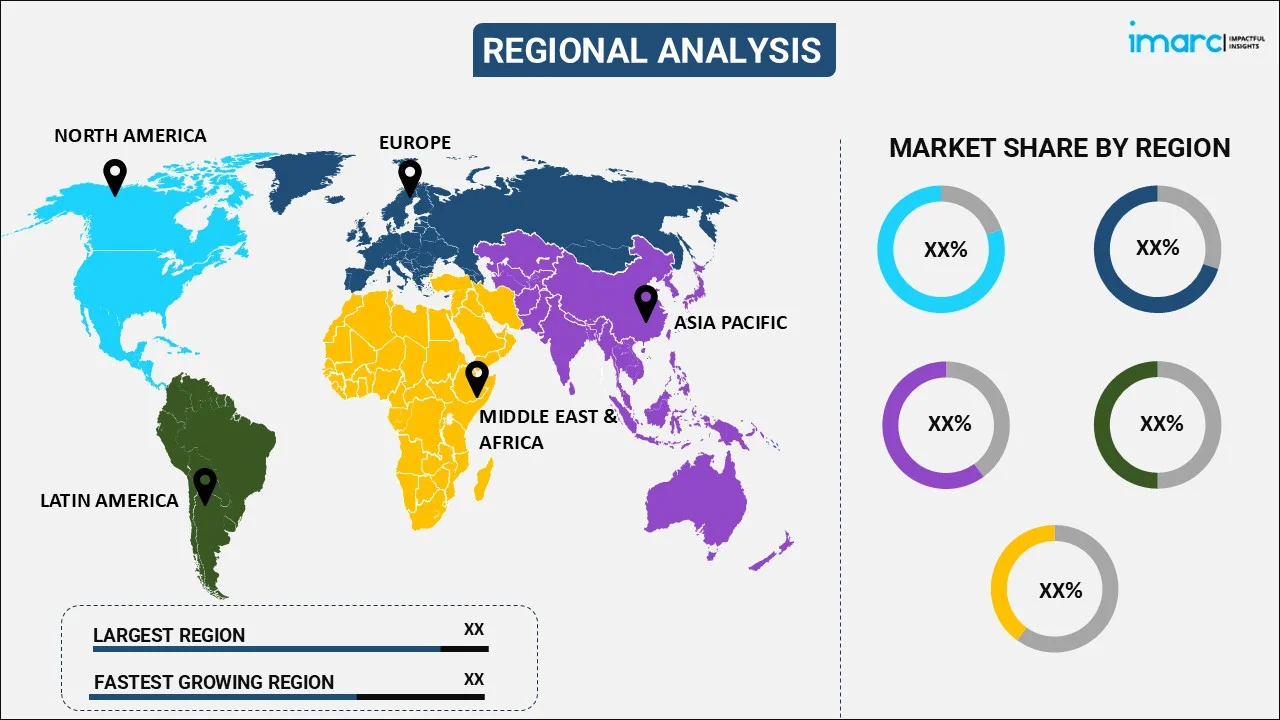
Connected Motorcycle Market Report by Service (Driver Assistance, Infotainment, Safety, Vehicle Management and Telematics, Insurance), Hardware (Embedded, Tethered), Network Type (Cellular V2X, Dedicated Short Range Communication), End User (Private, Commercial), and Region 2025-2033
Market Overview:
The global connected motorcycle market size reached USD 170.2 Million in 2024. Looking forward, IMARC Group expects the market to reach USD 2,066.1 Million by 2033, exhibiting a growth rate (CAGR) of 30.37% during 2025-2033.
|
Report Attribute
|
Key Statistics
|
|---|---|
|
Base Year
|
2024
|
|
Forecast Years
|
2025-2033
|
|
Historical Years
|
2019-2024
|
|
Market Size in 2024
|
USD 170.2 Million |
|
Market Forecast in 2033
|
USD 2,066.1 Million |
| Market Growth Rate 2025-2033 | 30.37% |
A connected motorcycle is an intelligent mobility solution that connects riders to the telematics control unit (TCU) through a cellular connection. It has a highly advanced system that alerts the rider about traffic conditions, potholes, road curves, oil level, tire pressure, and battery life. It also enables remote monitoring by tracking stolen vehicles, collecting data for performance analytics, and offering operational information, roadside assistance, and over-the-air (OTA) updates. At present, a considerable rise in the number of road accidents is escalating the demand for connected motorcycles worldwide to enhance driver safety.

The growing emphasis on driver safety and the increasing demand for a comfortable and safe riding experience are among the leading factors influencing the adoption of connected motorcycles for advanced assistance features. Moreover, road safety authorities worldwide are undertaking several initiatives to minimize fatal road accidents. This, along with the increasing reliance on smartphones and the rising deployment of 5G networks, is contributing to the market growth. Furthermore, app developers are creating two-wheeler-specific applications that provide motorcycle status, tamper alerts, and vehicle location. They also include automatic collision notification, remote diagnostics, and maintenance reminders. Apart from this, the leading players are integrating smart sensors, big data, and the Internet of Things (IoT) technologies to measure health and deliver real-time warnings to riders. They are also focusing on improving the safety, reliability, efficiency, and convenience of vehicle connectivity systems.
Key Market Segmentation:
IMARC Group provides an analysis of the key trends in each sub-segment of the global connected motorcycle market report, along with forecasts at the global, regional and country level from 2025-2033. Our report has categorized the market based on service, hardware, network type and end user.
Breakup by Service:

- Driver Assistance
- Infotainment
- Safety
- Vehicle Management and Telematics
- Insurance
Breakup by Hardware:
- Embedded
- Tethered
Breakup by Network Type:
- Cellular V2X
- Dedicated Short Range Communication
Breakup by End User:
- Private
- Commercial
Breakup by Region:

- North America
- United States
- Canada
- Asia-Pacific
- China
- Japan
- India
- South Korea
- Australia
- Indonesia
- Others
- Europe
- Germany
- France
- United Kingdom
- Italy
- Spain
- Russia
- Others
- Latin America
- Brazil
- Mexico
- Others
- Middle East and Africa
Competitive Landscape:
The competitive landscape of the industry has also been examined along with the profiles of the key players being Aeris, Autotalks Ltd., BMW AG, Continental AG, DXC Technology Company, Facomsa, IAV, KPIT Technologies Ltd, Panasonic Corporation, Robert Bosch GmbH, Starcom Systems Ltd and TE Connectivity.
Report Coverage:
| Report Features | Details |
|---|---|
| Base Year of the Analysis | 2024 |
| Historical Period | 2019-2024 |
| Forecast Period | 2025-2033 |
| Units | Million USD |
| Segment Coverage | Service, Hardware, Network Type, End User, Region |
| Region Covered | Asia Pacific, Europe, North America, Latin America, Middle East and Africa |
| Countries Covered | United States, Canada, Germany, France, United Kingdom, Italy, Spain, Russia, China, Japan, India, South Korea, Australia, Indonesia, Brazil, Mexico |
| Companies Covered | Aeris, Autotalks Ltd., BMW AG, Continental AG, DXC Technology Company, Facomsa, IAV, KPIT Technologies Ltd, Panasonic Corporation, Robert Bosch GmbH, Starcom Systems Ltd and TE Connectivity |
| Customization Scope | 10% Free Customization |
| Post-Sale Analyst Support | 10-12 Weeks |
| Delivery Format | PDF and Excel through Email (We can also provide the editable version of the report in PPT/Word format on special request) |
Key Questions Answered in This Report
The global connected motorcycle market was valued at USD 170.2 Million in 2024.
We expect the global connected motorcycle market to exhibit a CAGR of 30.37% during 2025-2033.
The rising emphasis on driver safety, along with the increasing integration of smart sensors, big data, and the Internet of Things (IoT) technologies with connected motorcycle to measure health and deliver real-time warnings to riders, is primarily driving the global connected motorcycle market.
The sudden outbreak of the COVID-19 pandemic had led to the implementation of stringent lockdown regulations across several nations, resulting in the temporary closure of numerous automobile manufacturing units, thereby negatively impacting the global market for connected motorcycle.
Based on the service, the global connected motorcycle market has been divided into driver assistance, infotainment, safety, vehicle management and telematics, and insurance. Among these, infotainment currently exhibits a clear dominance in the market.
Based on the hardware, the global connected motorcycle market can be categorized into embedded and tethered. Currently, embedded accounts for the majority of the global market share.
Based on the network type, the global connected motorcycle market has been segregated into cellular V2X and dedicated short range communication, where cellular V2X currently holds the largest market share.
Based on the end user, the global connected motorcycle market can be bifurcated into private and commercial. Currently, commercial exhibits a clear dominance in the market.
On a regional level, the market has been classified into North America, Asia-Pacific, Europe, Latin America, and Middle East and Africa, where Europe currently dominates the global market.
Some of the major players in the global connected motorcycle market include Aeris, Autotalks Ltd., BMW AG, Continental AG, DXC Technology Company, Facomsa, IAV, KPIT Technologies Ltd, Panasonic Corporation, Robert Bosch GmbH, Starcom Systems Ltd, and TE Connectivity.
Need more help?
- Speak to our experienced analysts for insights on the current market scenarios.
- Include additional segments and countries to customize the report as per your requirement.
- Gain an unparalleled competitive advantage in your domain by understanding how to utilize the report and positively impacting your operations and revenue.
- For further assistance, please connect with our analysts.
 Inquire Before Buying
Inquire Before Buying
 Speak to an Analyst
Speak to an Analyst
 Request Brochure
Request Brochure
 Request Customization
Request Customization




.webp)




.webp)












